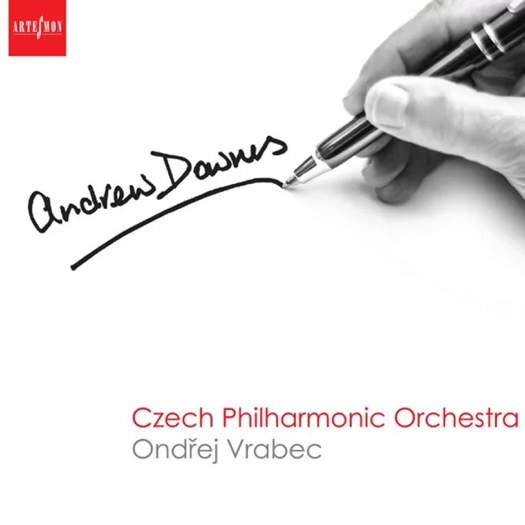 SPONSORED: CD Spotlight. On Buoyant Form - Orchestral music by Andrew Downes, heard by Roderic Dunnett.
SPONSORED: CD Spotlight. On Buoyant Form - Orchestral music by Andrew Downes, heard by Roderic Dunnett.
All sponsored features >>
 SPONSORED: Ensemble. Melting Rhapsody - Malcolm Miller enjoys Jack Liebeck and Danny Driver's 'Hebrew Melody' recital, plus a recital by David Aaron Carpenter.
SPONSORED: Ensemble. Melting Rhapsody - Malcolm Miller enjoys Jack Liebeck and Danny Driver's 'Hebrew Melody' recital, plus a recital by David Aaron Carpenter.
All sponsored features >>
 DISCUSSION: John Dante Prevedini leads a discussion about Composers, individuals or collective?, including contributions from David Arditti, Halida Dinova, Robert McCarney and Jane Stanley.
DISCUSSION: John Dante Prevedini leads a discussion about Composers, individuals or collective?, including contributions from David Arditti, Halida Dinova, Robert McCarney and Jane Stanley.
Not To Be Missed
GIUSEPPE PENNISI reports from a performance of Vivaldi's pastiche 'Tamerlano'
The musical theatre event not to be missed at this beginning of 2023 is Tamerlano, a 'pastiche' by Antonio Vivaldi, which debuted in Verona in 1735 and is, on the first occasion in modern times, proposed in scenic form by the Byzantine Academy of Ravenna. It was seen and heard at the Teatro Alighieri in Ravenna on 14 and 15 January 2023 and until late spring will tour to four other theaters in central Italy - Piacenza, Reggio Emilia, Modena, and Lucca - and then go to Poland and Spain. Thus, there are opportunities to experience this production in Italy as well as abroad.
For health reasons, I could not go to Ravenna, but the Byzantine Academy and the Teatro Alighieri ensured that I could follow the live afternoon performance on 15 January 2023, streamed at the link below this review, where it can be seen and heard for the next six months.
Tamerlano or 'The Death of Bajazet' (alternative title) is a common subject of Baroque theatre. (By the way, there is also a beautiful work by George Frideric Handel, often proposed in Germany.) In 2014, Opera Barga staged, and then recorded, Il Bajazet by Francesco Gasparini, an opera of 1719, and therefore shortly before Vivaldi's work, in the delightful Teatro Dei Differenti - less than 270 seats between stalls and boxes - of the Tuscan town. I reviewed it in Music & Vision Magazine on 20 July 2014.
The plot is typical of a Baroque opera. In Antonio Piovena's libretto, Bajazet (Bruno Taddia in this production), a valiant Turkish emperor, has been defeated by the Turkish-Mongol tyrant Tamerlano (Filippo Mineccia), who holds him prisoner in his palace together with his beloved daughter Asteria (Delphine Galou). The young woman loves the Greek prince Andronico (Federico Florio), but Tamerlano, already betrothed to Irene (Marie Lys), princess of Trebizond, has also fallen in love with her. Tamerlano, ignoring the love of Asteria and Andronico, confides in the prince and asks him to convince Bajazet to give him his daughter by offering him Irene's hand in exchange, thus freeing himself from his commitment. Idaspe, friend and confidant of Andronico (Giuseppina Bridelli) tries to find a solution to this intrigue.
Upon arrival at the palace, Irene discovers what is happening and, on the advice of Andronico, shows up at court in disguise to prevent the new intentions from coming to fruition. After a series of events, the engagement between Asteria and Tamerlano is announced in the throne room: Bajazet opposes it. Asteria publicly confesses that she agreed to marry Tamerlano only to kill him. She then reconciles with Bajazet and Andronico, but is held prisoner at court. During a banquet, Asteria attempts to kill Tamerlano by adding poison to a cup, but Irene prevents the emperor from drinking and reveals her identity. Bajazet introduces himself to Tamerlano announcing that he has poisoned himself to escape his tyranny, and promises to continue to torment him from the underworld. Asteria and Andronico plan suicide, but Tamerlano announces that he will marry Irene and leave Asteria and the throne of Byzantium to Andronico. The happy ending was the practice of Baroque opera and was later a feature of opera seria in the classical period too.
Let us come to the staging and direction. (Stage direction, sets and costumes are by Stefano Monti, and the lighting is by Eva Bruno.) How and where can a Greek prince, a Tatar tyrant, and a valiant Turkish emperor move? The scene, an abstract naked stage that, with a few props, is transformed into the various places of Tamerlano‘s palace - the prison, the banquet hall and the gardens. Various shades of gray dominate. The costumes are almost all in black and refer to an abstract Middle Eastern Ages.
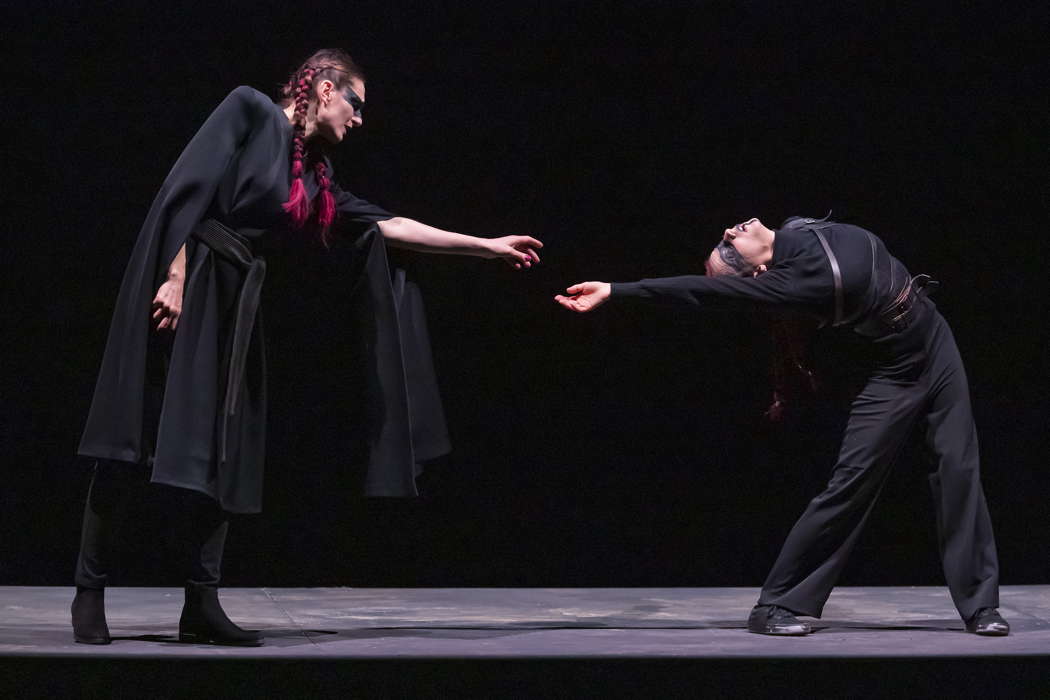
Delphine Galou singing Asteria, with dancer Elda Bartolacci in Vivaldi's Tamerlano. Photo © 2023 Zani Casadio
The work is structured in 'dry recitatives' and arias (with a few pieces for several voices - a magnificent quartet at the end of the first act and a chorus of the whole company at the end of the opera). The story is essentially 'told' by the six singers, and each of them is flanked by a dancer (from the Dacru Dance Company), who expresses their feelings. This moves the scenic action.
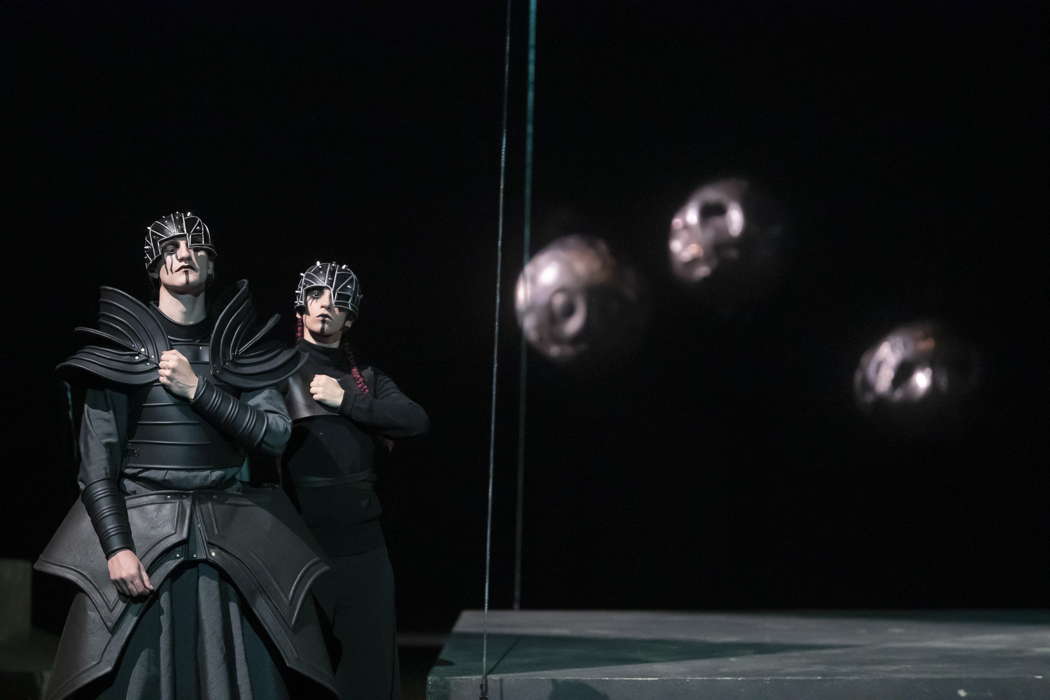
Federico Fiorio singing Andronico and dancer Grazina Marzia in Vivaldi's Tamerlano. Photo © 2023 Zani Casadio
Of course, Tamerlano, like much of Baroque opera, requires a theater of small dimensions like those of Central Italy. In Rome, it could be staged in Argentina or il Valle Thetre, and in Milan at the Filodrammatici Theatre - certainly not at the Teatro dell'Opera or at La Scala.
Now the musical aspects. The critical edition by Bernardo Ticci, published in 2019, was, for this production, revisited by Ottavio Dantone who conducted the small ensemble in the pit and played the harpsichord. It is difficult for those who are not experts in musical philology to say what the differences are. Since it is a 'pastiche', the arias (and the rare pieces for several voices) are not uniquely by Vivaldi. At that time, it was indeed common practice among composers to borrow and adapt arias from other composers into their own works. Vivaldi himself composed for Tamerlano his own arias for the 'good' characters - Bajazet, Asteria and Idaspe - while for the 'evil' ones - Tamerlano, Irene and Andronico - he used arias by other composers: Johann Adolf Hasse, Riccardo Broschi and Geminiano Giacomelli. Some arias were 'borrowed' from Vivaldi's earlier operas. This allows the audience to have an overview of the 'state of the art' in the first half of the eighteenth century.
The performance by the Byzantine Academy, which also recorded a CD of the work about two years ago, was excellent, as always. Dantone has emphasized the dramatic aspects of the work since the tripartite symphony - Allegro, Andante molto, Allegro.
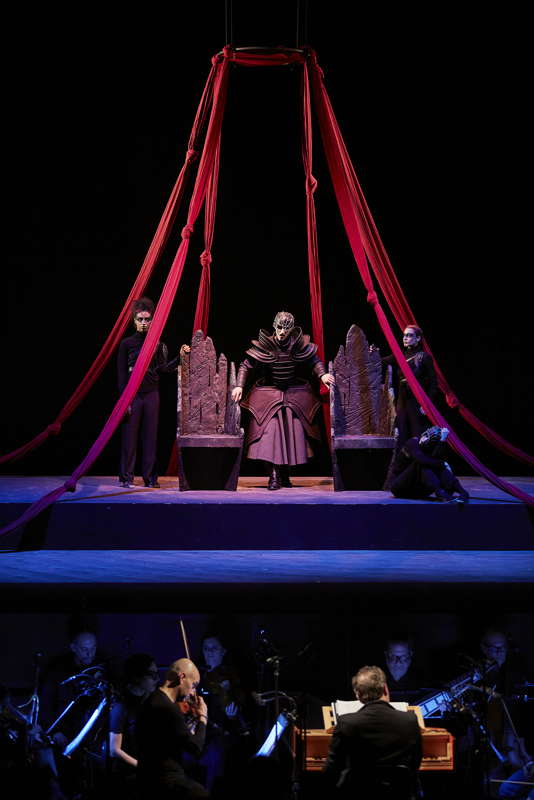
Dancer Kyda Pozza, Federico Fiorio singing Andronico and dancers Elda Bartolacci and Graziana Marzia, with, below, members of the Byzantine Academy, in Vivaldi's Tamerlano. Photo © 2023 Zani Casadio
The voices are all those of specialists in this repertoire. Filippo Mineccia is one of the greatest Italian countertenors: with his very high register, he manages to convey well the cruelty of the Mongol emperor and his final 'redemption'.
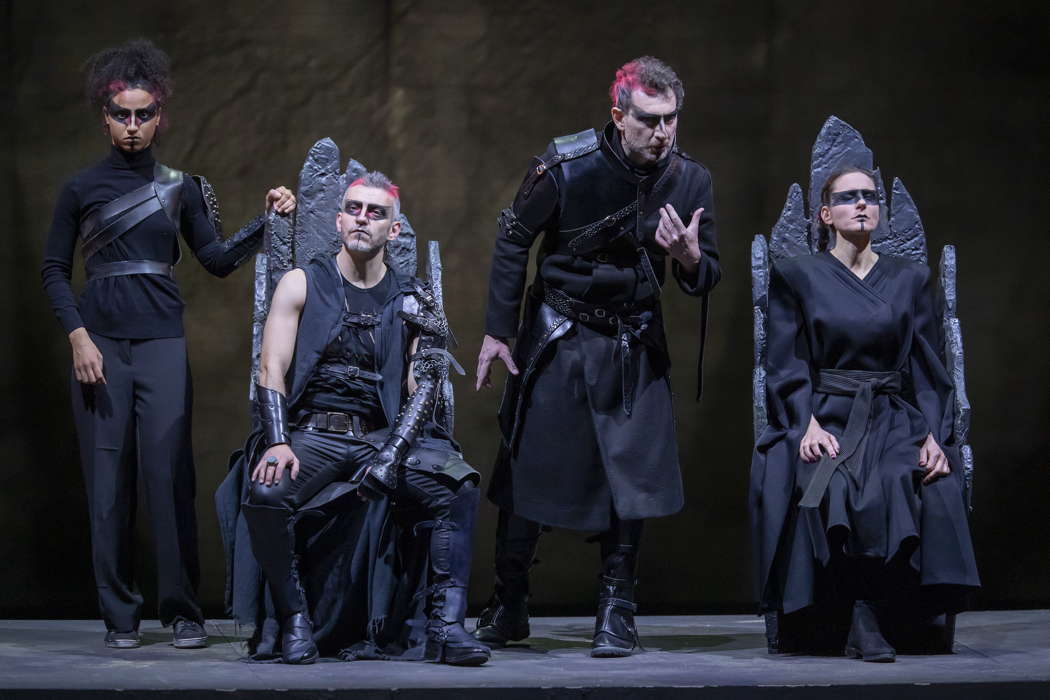
Dancer Kyda Pozza, Filippo Mineccia singing Tamerlano, Bruno Taddia singing Bajazet and Delphine Galou singing Asteria in Vivaldi's Tamerlano. Photo © 2023 Zani Casadio
Federico Fiorio is another countertenor who has done well with other works by Vivaldi.
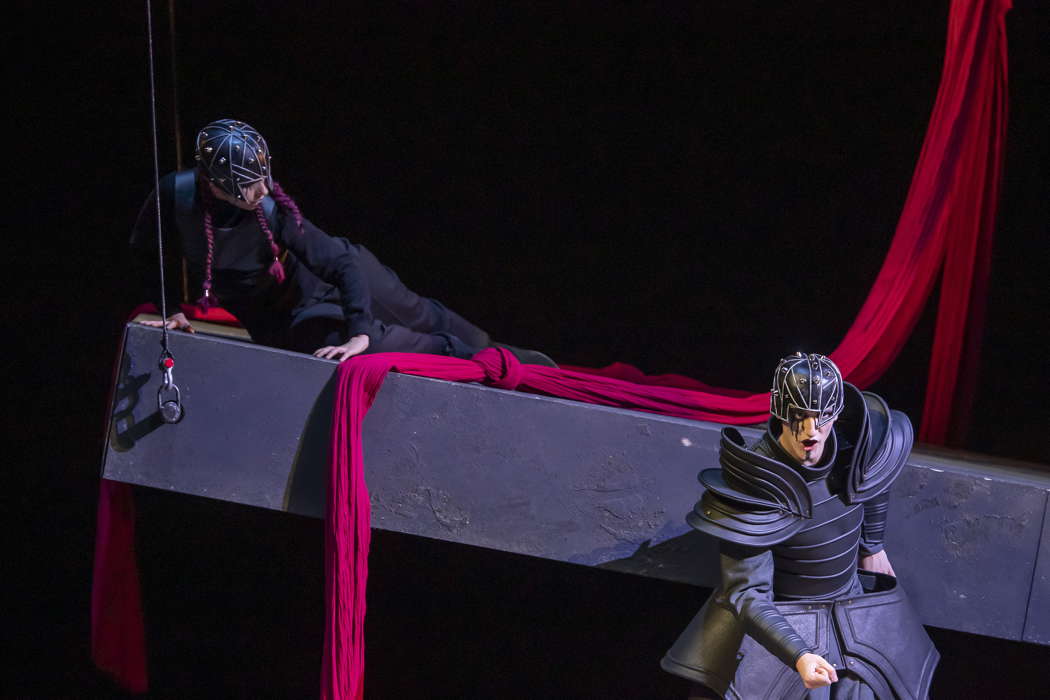
Federico Fiorio singing Andronico with dancer Graziana Marzia in Vivaldi's Tamerlano. Photo © 2023 Zani Casadio
Bruno Taddia is a young bass-baritone with a vast repertoire, ranging from Baroque to Puccini: a solid Bajazet.
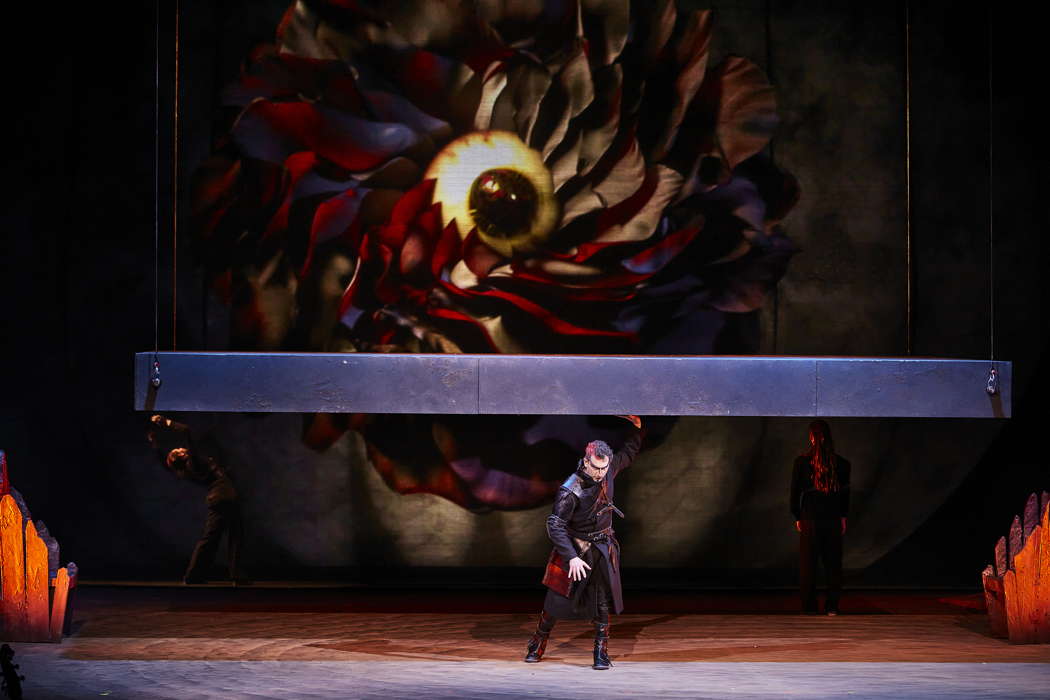
Bruno Taddia singing the role of Bajazet in Vivaldi's Tamerlano.
Photo © 2023 Zani Casadio
In the women's group, Delphine Galou's Asteria and Marie Lys' Irene excel; they have particularly difficult arias.
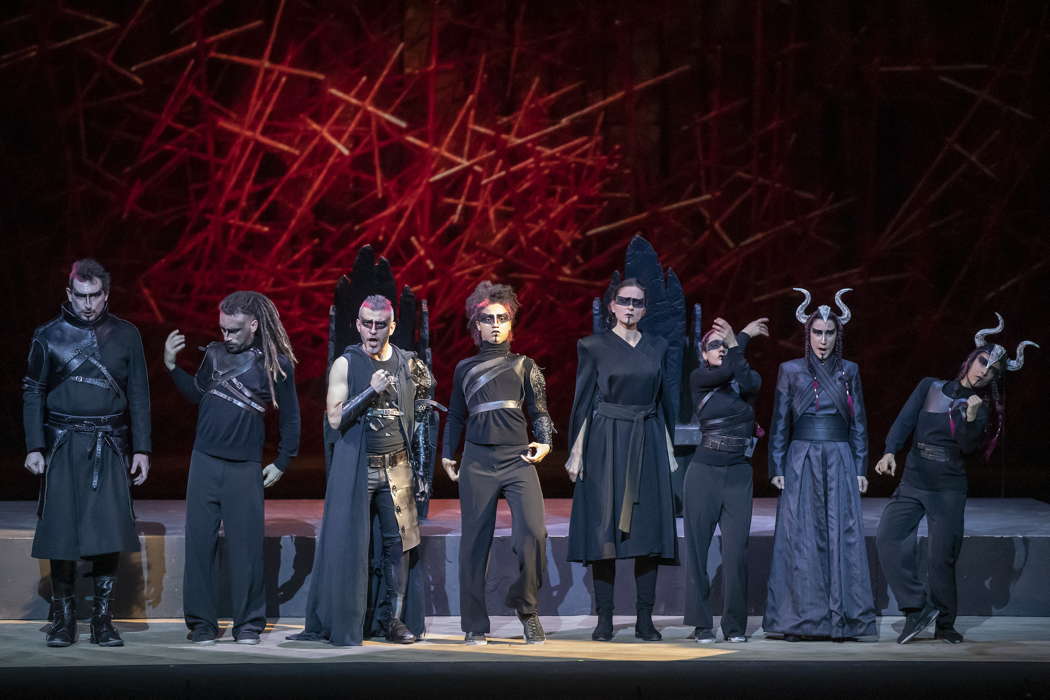
From left to right: Bruno Taddia singing Bajazet, dancer Davide Angelozzi, Filippo Mineccia singing Tamerlano, dancer Kyda Pozza, Delphine Galou singing Asteria, dancer Elda Bartolacci, Marie Lys singing Irene and dancer Alessandra Ruggeri in Vivaldi's Tamerlano. Photo © 2023 Zani Casadio
Giuseppina Bridelli's Idaspe was also of a good level.
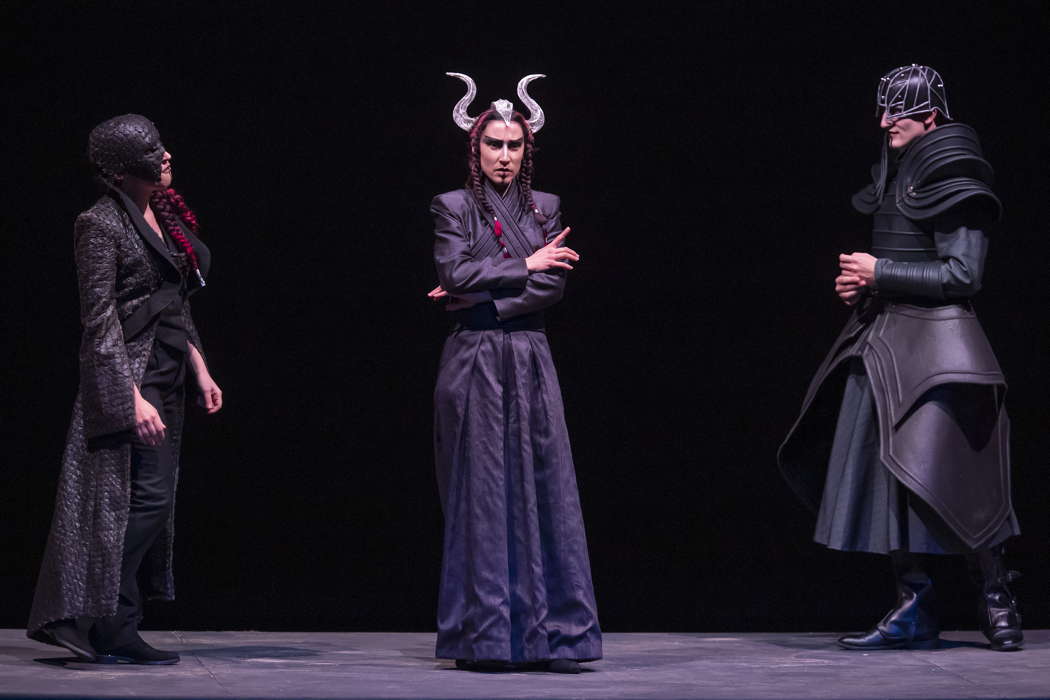
Giuseppina Bridelli singing Idaspe, Marie Lys singing Irene and Federico Fiorio singing Andronico in Vivaldi's Tamerlano. Photo © 2023 Zani Casadio
The performance was a great success; there was open stage applause after the most difficult arias, and there were accolades at the end.
Copyright © 17 January 2023
Giuseppe Pennisi,
Rome, Italy



